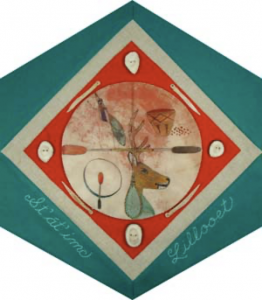St’at’imc

The Block
St’át’imc artist Ted Napoleon, of the T’it’q’et band, designed and created this block to reflect the economic and social aspects of his people’s way of life. The centrepiece is a hand-drum; a major method of musical expression in the tradition of the St’át’imc people. A double paddle, which separates the drum into quadrants, tells of their great skill in building canoes, and manoeuvring through waterways. Other vital components of the St’át’imc culture are hand-painted on the taut deer hide. A woven cedar-root basket represents the ongoing use of resources gathered from the land. A personal hand-drum, like those often used in ceremonial rituals and events, connects the people to their spiritual traditions. The salmon and deer illustrate the respect the Lillooet–who take only what they need–have for their environment. The buttons and bone-needles surrounding the drum are made from deer antlers.
Cultural Profile
The historical land of the St’át’imc (pronounced “Stat-li-um”), or Lillooet, First Nation, measures 160 kilometres by 160 kilometres and lies in the plateau region of south-central British Columbia, nestled between the Rocky Mountains and Pacific Coastal Range. Both Northern and Southern dialects of their language, St’at’imcets, belong to the Salishan linguistic group.
Using hook and line, seines, spears or weir traps, the St’át’imc still fish in the vast waterways of the Fraser River and its tributaries for salmon, their dietary staple . The St’át’imc value their way of life and follow traditional principles that emphasize sharing what they have with others and preserving their culture. Thus, traditional knowledge and skills, such as hunting and gathering, and preserving food for winter by smoking or sun-drying, are passed on to the next generation. Their expertise in basket-weaving has developed into a main industry.
Sponsor: Elizabeth & Gordon Ferguson
